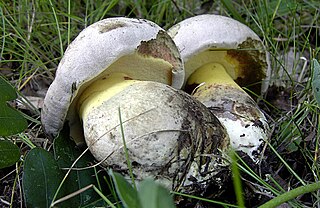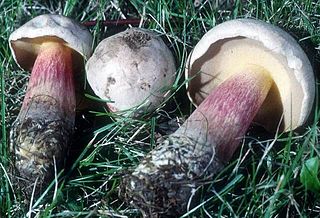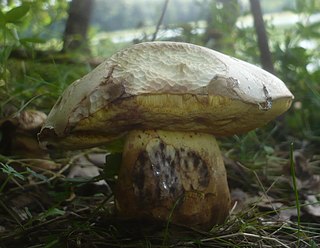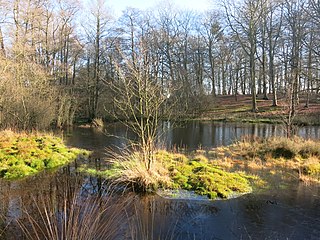
Caloboletus calopus, commonly known as the bitter beech bolete or scarlet-stemmed bolete, is a fungus of the bolete family, found in Asia, Northern Europe and North America. Appearing in coniferous and deciduous woodland in summer and autumn, the stout fruit bodies are attractively coloured, with a beige to olive cap up to 15 cm (6 in) across, yellow pores, and a reddish stipe up to 15 cm (6 in) long and 5 cm (2 in) wide. The pale yellow flesh stains blue when broken or bruised.

The Chinese leaf warbler is a species of Old World warbler in the family Phylloscopidae. Its natural habitats are subtropical or tropical dry forests and subtropical or tropical high-altitude shrubland. It is found only in China.

Pinus yunnanensis, the Yunnan pine, is a species of conifer in the family Pinaceae. It is found in the Chinese provinces of Yunnan, Sichuan, Guizhou, and Guangxi.

The Yunnan box turtle is a species of turtle in the family Geoemydidae. It is believed to be endemic to Yunnan, China and was suspected to be extinct since the early 20th century; the last verified specimen was collected in 1940.

Caloboletus radicans, also known as the rooting bolete or whitish bolete, is a large ectomycorrhizal fungus found in Europe under broad-leaved trees, fruiting during the summer and autumn months. It has a pale buff or greyish-white cap, yellow pores and a stout stipe, and stains intensely blue when handled or cut. Bitter and inedible, it can cause severe vomiting and diarrhoea if eaten. Until 2014 it was placed in genus Boletus, but has since been transferred to the new genus Caloboletus based on molecular phylogenetic data.
Trimeresurus yunnanensis, commonly known as the Yunnan bamboo pitviper, is a venomous pitviper species endemic to China.

Malus yunnanensis is a species in the genus Malus, family Rosaceae, with the common name Yunnan crabapple. In Mandarin Chinese, it is called “滇池海棠”.
Vitis yunnanensis is a species of liana in the grape family native to the Chinese province of Yunnan. It is a forest dweller, found at various elevations between 500 and 1800 meters. In August it bears globular berries.
Musa yunnanensis, commonly known as either Yunnan banana or wild forest banana, is a recently described plant in the banana and plantain family native to Yunnan in southern China. The type specimen was collected in 2005 in Xishuangbanna, at an elevation c. 1,150 meters.

Amanita pseudoporphyria, also known as Hongo's false death cap, is a species of agaric fungus from the genus Amanita.

Caloboletus inedulis is a bolete fungus of the family Boletaceae that is native to North America. Until 2014, it was known as Boletus inedulis. Recent changes in the phylogenetic framework of the Boletaceae prompted the transfer of this species, along with several other related boletes, including Caloboletus calopus, to the genus Caloboletus. The species is inedible.

Caloboletus firmus is a bolete fungus native to North America. Until 2014, it was known as Boletus firmus. Recent changes in the phylogenetic framework of the family Boletaceae prompted the transfer of this species, along with several other related boletes, including Caloboletus calopus, to the genus Caloboletus. It was first described scientifically in 1874 by American botanist Charles Christopher Frost from specimens collected in New England.
Butyriboletus peckii is a fungus of the genus Butyriboletus native to eastern North America. It was first described by Charles Christopher Frost in 1878. Until 2014, it was known as Boletus peckii. Recent changes in the phylogenetic framework of the Boletaceae prompted the transfer of this species, along with several other related boletes, including Caloboletus calopus, to the genus Caloboletus. In 2015, Kuan Zhao and colleagues published analysis that demonstrated that the bolete belongs to Butyriboletus, closely related to Butyriboletus pulchriceps.
The Yunnan bush rat is a species of rodent from the family Muridae. It has just recently been released from synonymy with the Manipur bush rat, and so there is very little information about it. It was recognized as a separate species due to its much larger body size in comparison to the Manipur bush rat, relatively shorter tail, pure white underparts as opposed to gray, significantly shorter diastema, and shorter palate in relation to its skull. It is located only in Yunnan province of the People's Republic of China, where it known only from Tongbiguan Nature Reserve in Ruili City.

Caloboletus is a fungal genus in the family Boletaceae. It was circumscribed by Italian mycologist Alfredo Vizzini with Caloboletus calopus as the type species. The erection of Caloboletus follows recent molecular studies that outlined a new phylogenetic framework for the Boletaceae. Boletus peckii was also transferred to this genus by Vizzini, but was subsequently moved to the genus Butyriboletus based on molecular evidence. The generic name Caloboletus, derived from the Greek calos "nice", refers to the attractive red coloring of the stipe.

Caloboletus frustosus is a bolete fungus native to North America. Until 2014, it was known as Boletus frustosus. Recent changes in the phylogenetic framework of the family Boletaceae prompted the transfer of this species, along with several other related boletes, including Caloboletus calopus, to the genus Caloboletus. It was first described scientifically in 1941 by mycologists Wally Snell and Esther Dick.
Caloboletus panniformis is a bolete fungus native to Honshu island in Japan, where it grows under conifers in subalpine regions. Until 2014, it was known as Boletus panniformis. Recent changes in the phylogenetic framework of the family Boletaceae prompted the transfer of this species, along with several other related boletes, including Caloboletus calopus, to the genus Caloboletus. It was first described scientifically in 2013 by Japanese botanist Haruki Takahashi and colleagues.

Caloboletus kluzakii is a bolete fungus native to Europe. Until 2014, it was known as Boletus kluzakii. Recent changes in the phylogenetic framework of the family Boletaceae prompted the transfer of this species, along with several other related boletes, including Caloboletus calopus, to the genus Caloboletus. It was described scientifically in 2006 by Josef Šutara and Pavel Špinar, from specimens collected in the Czech Republic. The fungus had earlier been published with the name Boletus fallax by Czech mycologist Zdeněk Kluzák in 1988, but this was invalid, as that name had been used previously by E.J.H. Corner for a Malaysian bolete. The epithet honours Kluzák's contributions in describing the species.

Sole Common Pond is a 3-hectare (7.4-acre) nature reserve south-west of Boxford in Berkshire in Berkshire. It is managed by the Berkshire, Buckinghamshire and Oxfordshire Wildlife Trust.











